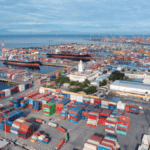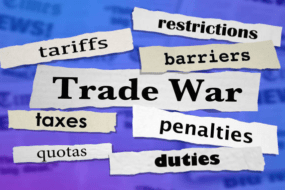- Home
- Trade News
- Italy Imports More Gas, Less T ...

Here’s something interesting about Italy’s import behaviour in 2025: while some countries scramble to steady their supply chains, Italy seems to be quietly redrawing the map.
On the one hand, it’s bringing in more gas, especially from sources outside Russia, while on the other, it’s scaling back on textiles and palm oil, both long-time staples of its import profile. It sounds like a deliberate shift, but is it about strategy or simply a reaction to wider market pressures?
At first glance, this might look like standard global trade evolution, but if we read between the lines, there’s a deeper story about how Italy positions itself for future resilience, even if that means letting go of certain industries. Let’s take a closer look at it.
Increasing Italy Imports of Gas and Machinery
Italy’s import focus in 2025 has taken a decisive turn toward energy and industry, with a sharp rise in gas and machinery purchases that marks a clear shift in trade strategy.
In a year where global supply chains remain unpredictable, and energy security has taken centre stage, Italy’s imports reveal the country is doubling down on resilience.
The rise in equipment, metals, and organic chemicals supports everything from motor vehicles to pharmaceuticals, further anchoring Italy’s competitive edge in core sectors.
Gas From Azerbaijan and Ukraine
Italy’s growing reliance on natural gas from Azerbaijan and Ukraine is one of the most striking developments this year. This move, widely reported in 2025, signals a calculated effort by the Italian Republic to sever its longstanding dependence on Russian gas. Given the geopolitical tensions in the region, this relationship has become increasingly untenable.
This diversification strategy is not only politically motivated but also economically smart. Gas imports from Azerbaijan have ramped up significantly via the Trans Adriatic Pipeline (TAP), while smaller but symbolic imports from Ukraine represent a gesture of solidarity and strategic alignment.
Other Imports on the Rise
It’s not just gas flowing into Italy these days. According to a recent report, the country’s total import value has increased by 4.1%, driven by a sharp 39.6% surge in foreign natural gas purchases.
The jump comes amid higher power demand and supply disruptions caused by halted flows from Ukraine. These conditions are pushing prices up and forcing Italy to diversify its energy sources more aggressively.
But energy isn’t the only item driving the increase. Foreign purchases of pharmaceutical goods jumped by 21%, pointing to Italy’s push to bolster its healthcare and biotech sectors.
Meanwhile, imports of food and beverages rose by 8.2%, perhaps reflecting both rising domestic consumption and inflationary pressures. Transportation goods also rose, indicating renewed momentum in infrastructure and mobility investments.
So while energy headlines might dominate, the bigger picture shows Italy recalibrating its import mix to meet immediate needs and support broader goals in public health, mobility, and industrial resilience.
Reduced Italy Imports
While Italy’s energy and industrial goods imports have surged, the country has dialled back significantly on certain other products. Textiles and palm oil have seen marked declines in 2025.
This development may appear subtle, but it points to deeper shifts in Italy’s trade statistics, policy priorities, and sustainability goals.
Less Textiles
Recent data shows Italy’s textile imports are declining, with sales in the broader category of textiles, clothing, leather, and accessories falling by 4.5%. Once a steady consumer of fast-fashion fabrics from Asia and parts of Africa, Italy appears to be cooling on low-cost imports.
Part of the shift could be linked to growing pressure to clean up supply chains. As the European Union doubles down on environmental and labour standards, fast-fashion imports, often criticised for their carbon footprints and poor working conditions, are falling out of favour.
There’s also speculation that domestic manufacturing is slowly regaining ground. Whether through policy support or changing consumer attitudes, Italy may choose quality over quantity, leaning toward more sustainable regional supply networks in line with broader EU goals.
Less Palm Oil
Palm oil is also on the decline. A report released in April 2025 confirms that Italian palm oil imports have continued to fall, which is part of a broader European trend.
The EU has long taken a tough stance on palm oil over environmental concerns, including deforestation and biodiversity loss. Italy’s drop in imports seems to echo this commitment.
But there’s another angle worth noting. Italy is importing more than half of its food products from sources that comply with traceability and deforestation-free supply chain standards.
Given how integral palm oil is to processed foods, soaps, and cosmetics, the import drop may force Italian manufacturers to find alternatives or shift toward sustainable palm oil certification schemes.
Italy Looks To Strengthen Zimbabwe Trade Relations
In a development that might have flown under the radar, Italy is also turning its attention south, to Zimbabwe, to be exact. Reports highlighted Rome’s intent to deepen trade ties with Harare, signalling Italy’s import strategy shifting towards new partners in other continents.
Why Zimbabwe? It might seem an unlikely choice on paper, but the numbers say otherwise. The Italian Republic is Zimbabwe’s 11th biggest export market, with major categories including precious stones, raw materials, and food commodities. There’s an existing foundation for further cooperation.
Italy Is Zimbabwe’s 11th Biggest Export Market
Italy’s status as Zimbabwe’s 11th-largest export destination country is more than symbolic; it indicates mutual interest and substantial room to grow. Italy imported over €100 million worth of goods from Zimbabwe in the last fiscal cycle, and officials believe this figure could double within a few years.
The partnership is compelling because of the complementary nature of their economies. Zimbabwe has abundant natural resources, while Italy has the technical capacity and industrial know-how to refine and capitalise on them.
EU-Eastern and ESA Economic Partnership Agreement
The EU-Eastern and Southern Africa (ESA) Economic Partnership Agreement also enables this uptick in engagement. This agreement provides a framework for freer, fairer trade between European Union members and several African states, including Zimbabwe.
For Italy, the EPA offers a low-risk pathway to expand its global trade footprint and diversify away from traditional partners like Germany, France, and Spain.
Beyond the data, this relationship reflects a growing recognition that the world’s next major trade opportunities may lie outside the traditional G7 and BRICS blocs. With Africa fast emerging as a global growth engine, Italy seems to be positioning itself as an early mover, and Zimbabwe may be the start.
Italy’s Strong Trade Partnership With India
Italy is expanding its trade footprint across Africa and doubling down on long-standing economic relationships in Asia. India, in particular, has emerged as a key player in Italy’s evolving import strategy.
2025–2029 Strategic Action Plan
In early 2025, both governments launched a Strategic Action Plan to guide their bilateral economic relationship through 2029. The plan outlines shared goals in infrastructure, clean energy, digital transformation, and defence, but the trade commitments stand out.
Italy is keen to source more industrial materials, engineering components, and pharmaceuticals from India, which is increasingly positioning itself as a manufacturing powerhouse.
More than a diplomatic gesture, the action plan is a blueprint for turning political goodwill into real commercial flows. The plan focuses on reducing barriers, increasing investment, and encouraging private-sector cooperation, which could give Italy a steady supply of goods that match its growing industrial appetite.
Italy Is India’s 4th-Largest Trading Partner in Imports
Italy is now officially India’s 4th-largest trading partner in import volumes. That means Italian demand for Indian goods, everything from refined petroleum to organic chemicals, leather, and engineering products, has reached new highs.
Its comparative advantages in low-cost production and skilled labour perfectly complement Italy’s need for high-volume, high-quality inputs to fuel its manufacturing, automotive, and energy sectors.
And while India is climbing the ranks, it’s doing so while playing by the rules of sustainable, traceable trade, something the EU deeply values. As Italy seeks to diversify its energy sources away from Russia and manufacturing inputs away from China, India is emerging as a key alternative partner.
Recap: Leading Italy Import Partners
So where does Italy turn when it needs to power its factories, fuel its homes, and stock its supermarket shelves? A quick snapshot of its leading import partners shows how the country is rebalancing its trade approach in 2025.
Top Import Partners
- Germany
- France
- China
- India
- Netherlands
- Spain
- Belgium
- United States
- Azerbaijan
- Ukraine
These countries are vital sources of strategic imports; many are Italy’s counterparts in outbound trade. For instance, as Italy exported more to regions like the Middle East, it adjusted its import dependencies, particularly in energy and industrial goods.
It’s a dynamic dance: what Italy brings in fuels what Italian exports can offer. And while the spotlight here is on imports, the strength and adaptability of total exports also play a huge role in shaping these trade decisions.
Major Italy Imports
And what exactly is Italy bringing in? Here are the top import categories driving the numbers:
- Mineral fuels, oils, and distillation products
- Machinery and mechanical appliances
- Electrical equipment
- Pharmaceuticals
- Vehicles and transport equipment
- Organic chemicals
- Iron and steel
- Precious stones and metals
- Plastics and polymers
The trend is clear: Italy prioritises high-value, strategic imports that align with its domestic growth plans. Whether it’s energy independence, industrial expansion, or diversifying trade partners, 2025 will be a pivotal year in Italy’s import strategy, and the story is far from over.
Conclusion: Italy’s Trade Priorities Are Shifting—Quietly but Clearly
So, what can we make of it all? Italy’s decision to import more gas while easing off on textiles and palm oil might look practical to meet its current energy needs, especially with tensions still casting shadows over European energy corridors.
Now, whether this trade-off pays off in the long run will depend on how flexible Italy remains as global supply chains continue to shift. If the demand for sustainable resources, industrial input, and food security rises, being agile will matter more than ever.
At TradeDataPro, understanding these global shifts is crucial, whether you’re tracking Italian imports, exploring global trade patterns, or identifying emerging market trends. For in-depth insights and reliable trade statistics from more than half the world’s economies, visit our official website.








